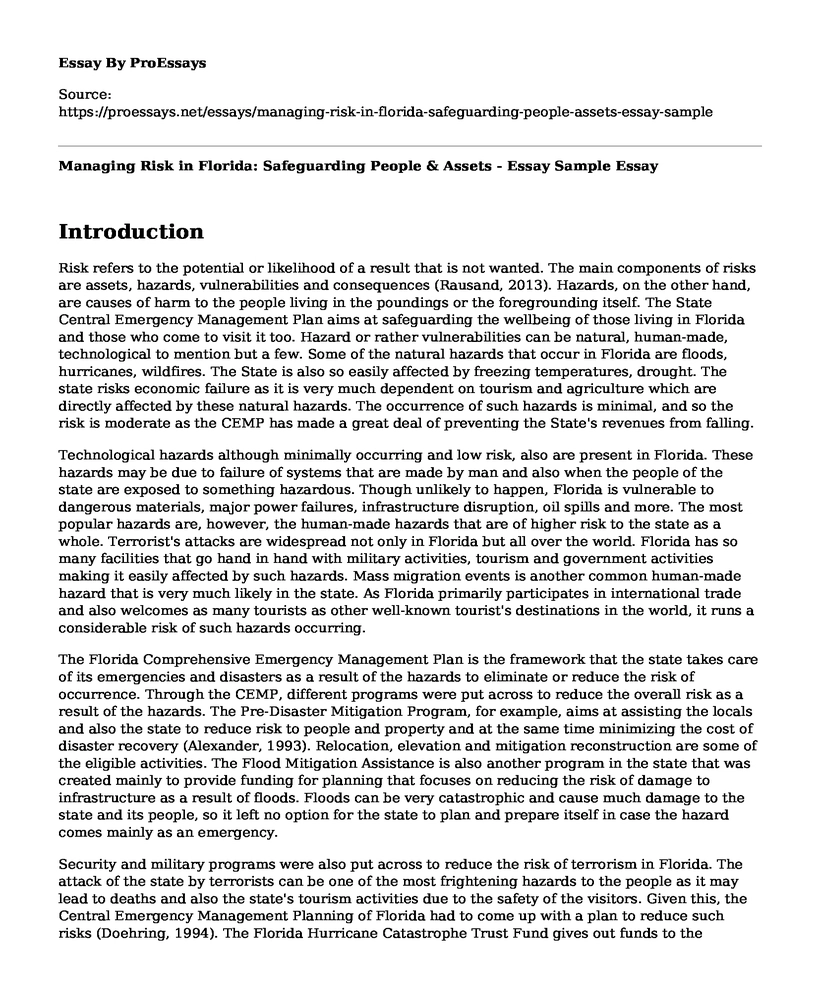Introduction
Risk refers to the potential or likelihood of a result that is not wanted. The main components of risks are assets, hazards, vulnerabilities and consequences (Rausand, 2013). Hazards, on the other hand, are causes of harm to the people living in the poundings or the foregrounding itself. The State Central Emergency Management Plan aims at safeguarding the wellbeing of those living in Florida and those who come to visit it too. Hazard or rather vulnerabilities can be natural, human-made, technological to mention but a few. Some of the natural hazards that occur in Florida are floods, hurricanes, wildfires. The State is also so easily affected by freezing temperatures, drought. The state risks economic failure as it is very much dependent on tourism and agriculture which are directly affected by these natural hazards. The occurrence of such hazards is minimal, and so the risk is moderate as the CEMP has made a great deal of preventing the State's revenues from falling.
Technological hazards although minimally occurring and low risk, also are present in Florida. These hazards may be due to failure of systems that are made by man and also when the people of the state are exposed to something hazardous. Though unlikely to happen, Florida is vulnerable to dangerous materials, major power failures, infrastructure disruption, oil spills and more. The most popular hazards are, however, the human-made hazards that are of higher risk to the state as a whole. Terrorist's attacks are widespread not only in Florida but all over the world. Florida has so many facilities that go hand in hand with military activities, tourism and government activities making it easily affected by such hazards. Mass migration events is another common human-made hazard that is very much likely in the state. As Florida primarily participates in international trade and also welcomes as many tourists as other well-known tourist's destinations in the world, it runs a considerable risk of such hazards occurring.
The Florida Comprehensive Emergency Management Plan is the framework that the state takes care of its emergencies and disasters as a result of the hazards to eliminate or reduce the risk of occurrence. Through the CEMP, different programs were put across to reduce the overall risk as a result of the hazards. The Pre-Disaster Mitigation Program, for example, aims at assisting the locals and also the state to reduce risk to people and property and at the same time minimizing the cost of disaster recovery (Alexander, 1993). Relocation, elevation and mitigation reconstruction are some of the eligible activities. The Flood Mitigation Assistance is also another program in the state that was created mainly to provide funding for planning that focuses on reducing the risk of damage to infrastructure as a result of floods. Floods can be very catastrophic and cause much damage to the state and its people, so it left no option for the state to plan and prepare itself in case the hazard comes mainly as an emergency.
Security and military programs were also put across to reduce the risk of terrorism in Florida. The attack of the state by terrorists can be one of the most frightening hazards to the people as it may lead to deaths and also the state's tourism activities due to the safety of the visitors. Given this, the Central Emergency Management Planning of Florida had to come up with a plan to reduce such risks (Doehring, 1994). The Florida Hurricane Catastrophe Trust Fund gives out funds to the Hurricane Loss Mitigation Program that aims at using the funds for shelter and also help all those affected by hurricanes. The state hazard mitigation plans all together aim at reducing injuries, deaths and loss of people's or even government property caused by hazards in Florida. The CEMP was therefore mainly developed due to vulnerability of hazards to reduce the risk to come with them. The hazards can be accidental but still risky such fires, hazardous material spills, major vehicle accidents to mention but a few.
References
Alexander, D.A., 1993. Natural Disasters. New York: Chapman and Hall.
Coletti, R.J. 1992: Swift recovery, stronger economy. Florida Trend, 35, 32-35.
Doehring, F., Duedall, I. W., & Williams, J. M. (1994). Florida hurricanes and tropical storms: 1871-1993, an historical review. Retrieved from http://aquaticcommons.org/id/eprint/360
Rausand, M. (2013). Risk assessment: theory, methods, and applications (Vol. 115). John Wiley & Sons. Retrieved from https://books.google.com/books?hl=en&lr=&id=9EHeLmbUVh8C&oi=fnd&pg=PT12&
Cite this page
Managing Risk in Florida: Safeguarding People & Assets - Essay Sample. (2023, Mar 09). Retrieved from https://proessays.net/essays/managing-risk-in-florida-safeguarding-people-assets-essay-sample
If you are the original author of this essay and no longer wish to have it published on the ProEssays website, please click below to request its removal:
- Consumer Problem Recognition Essay
- Strategic Communication in Project Management Paper Example
- Business Knowledge Management Paper Example
- Steps to Transform Teamwork Essay
- Essay Example on a Leader's Guide to Understanding People's Behaviors
- Essay Sample on Schools' Safety: Securing Kids' Future from Intruders & Active Shooters
- Paper Example on KraveBeauty Skincare: Cleansing Less for Better Skin Health







